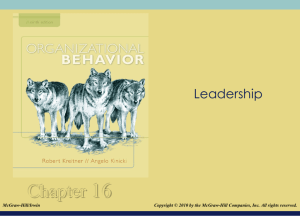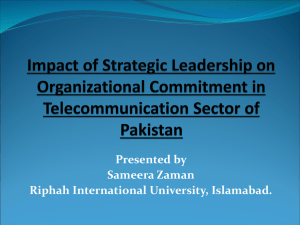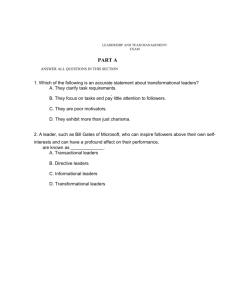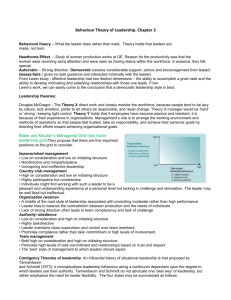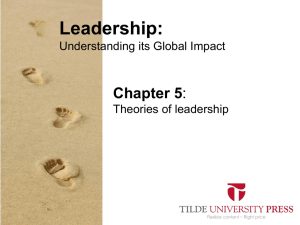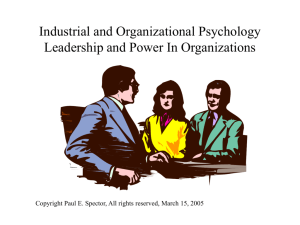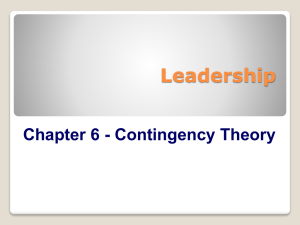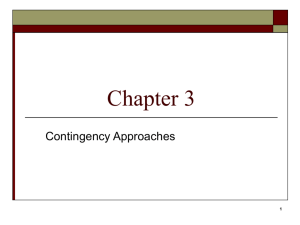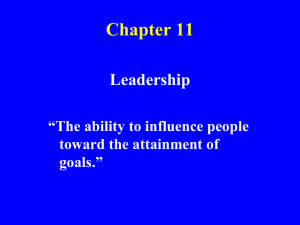Situational.doc
advertisement
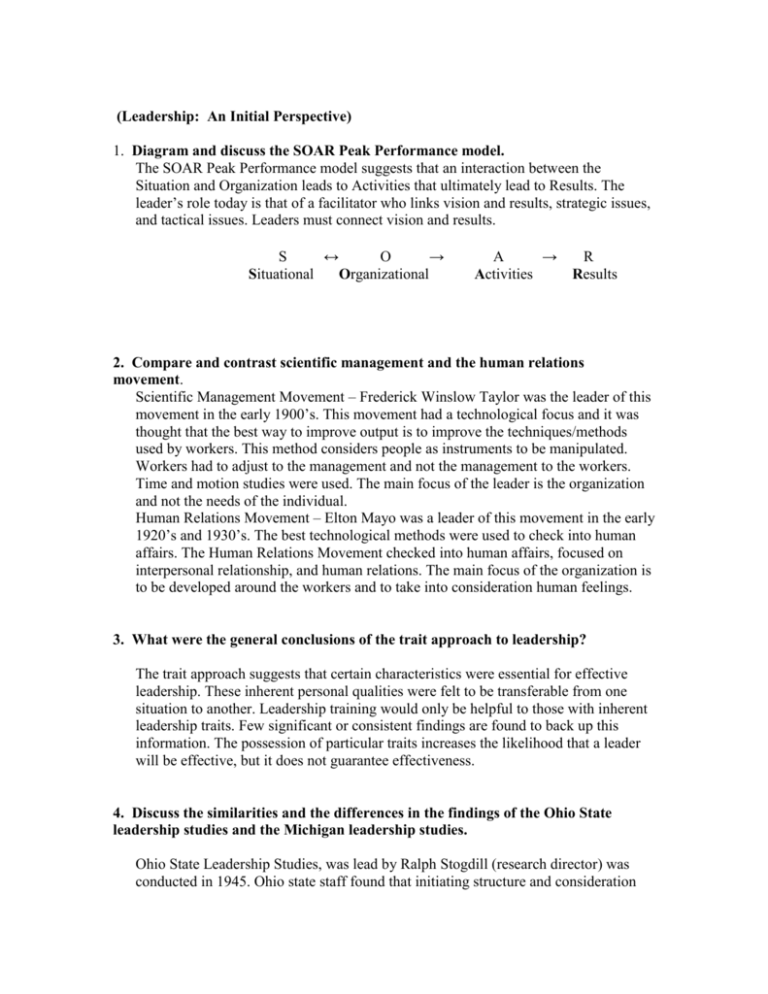
(Leadership: An Initial Perspective) 1. Diagram and discuss the SOAR Peak Performance model. The SOAR Peak Performance model suggests that an interaction between the Situation and Organization leads to Activities that ultimately lead to Results. The leader’s role today is that of a facilitator who links vision and results, strategic issues, and tactical issues. Leaders must connect vision and results. S ↔ O → Situational Organizational A → Activities R Results 2. Compare and contrast scientific management and the human relations movement. Scientific Management Movement – Frederick Winslow Taylor was the leader of this movement in the early 1900’s. This movement had a technological focus and it was thought that the best way to improve output is to improve the techniques/methods used by workers. This method considers people as instruments to be manipulated. Workers had to adjust to the management and not the management to the workers. Time and motion studies were used. The main focus of the leader is the organization and not the needs of the individual. Human Relations Movement – Elton Mayo was a leader of this movement in the early 1920’s and 1930’s. The best technological methods were used to check into human affairs. The Human Relations Movement checked into human affairs, focused on interpersonal relationship, and human relations. The main focus of the organization is to be developed around the workers and to take into consideration human feelings. 3. What were the general conclusions of the trait approach to leadership? The trait approach suggests that certain characteristics were essential for effective leadership. These inherent personal qualities were felt to be transferable from one situation to another. Leadership training would only be helpful to those with inherent leadership traits. Few significant or consistent findings are found to back up this information. The possession of particular traits increases the likelihood that a leader will be effective, but it does not guarantee effectiveness. 4. Discuss the similarities and the differences in the findings of the Ohio State leadership studies and the Michigan leadership studies. Ohio State Leadership Studies, was lead by Ralph Stogdill (research director) was conducted in 1945. Ohio state staff found that initiating structure and consideration were separate and distinct dimensions. The behavior of the leader could be described as any mix of initiating structure and consideration. Leader behavior was first plotted on two separate axes rather than on a single continuum. Quadrants were developed to show various combination of initiating structure and consideration. Stogdill defined leadership as the behavior of an individual when directing the activities of a group toward goal attainment, narrowed to two dimensions; initiating structure and consideration. Two questionnaires were used the LBDQ (Leader Behavior Description Questionnaire) and LOQ (Leader Opinion Questionaire). The Michigan Leadership Study attempted to study leadership by locating clusters of characteristics that seemed to be related and by determining various indicators of effectiveness they thought that they could predict leadership. Two concepts were identified, one was called employee orientation and the other production orientation. Employee-oriented-relationships are the aspect of their job that is most important, Production-oriented-emphasized the production and technical aspects of the job, the two orientations are democratic (relationship based) and authoritarian (task based). 5. Consider the group dynamics studies and Rensis Likert’s management systems. What are some similarities? The group dynamics have two main categories: the achievement of some specific group goal and the maintenance or strengthening of the group itself. The Renesis linkert’s systems works to strengthen the employees by being employee centered. The Linkert systems also look at a more job centered management style. The description of these systems gives an idea of working with groups as well as the group dynamics. The Linkert systems uses the group dynamics studies as a starting point to research more specifically and build on those 2 main categories. -----------------------------------------------------------------------------------------------------------(Leadership: Situational Approaches) 1. Why study situational approaches to leadership? A situational view is necessary to portray accurately the complexities of the leadership process. The contribution of a leader’s actions to the effectiveness of his/her organization can not be determined without considering the nature of the situation in which the behavior is displayed. 2. Compare and contrast the Tannenbaum-Schmidt Continuum of Leader Behavior and Fiedler’s Leadership Contingency model. The TSC is chosen and is either task oriented or relationship oriented. The followers have more freedom. Fiedler’s style is chosen by the situation and presents more of a balance. TSC creates a more lazier-faire type atmosphere. The other end of the TSC is the exact opposite. The leadership is authoritarian without follower input on everything. Fiedler’s allows the situation to determine what style is most appropriate. It appears to be more balanced in leadership and follower collaboration to make decisions 3. What does a contingency approach to leadership mean? Why is the VroomYetten Model called a contingency model? The elements of the this model are contingent on each other to provide an effective outcome. The situation calls for a certain leadership. The impact and outcome is contingent on the leader behavior and the impact of the behavior determines the outcome, therefore affect organizational effectiveness. All the elements interact together 4. Discuss the Tridimensional Leader Effectiveness model. What are the three dimensions? What are some of the features that make it more directly relevant to actual managers than some theories? The three dimensions are Relationship Behavior, Task Behavior, and effectiveness. This model allows more freedom for the leader. Some situations may call for quick turn around with decisions that require the leader to use direct control, but the leader could return at a time that the followers could be included in other decisions. 5. What is consistency? Give examples where the same leadership behaviors would be inconsistent. Consistent leadership is not using the same leadership style all the time, but using the styles appropriate for the follower’s level of readiness in such a way that followers understand why they are getting a certain behavior, a certain leadership style. An example of being inconsistent with the same leadership behavior would be when you have two teachers. One teacher never arrives to work on time. He is consistently late. The other teacher is always on time if not early. Praising all the teachers for arriving to work on time is inconsistent because the praise is not appropriate for all the teachers. Allowing both teachers to leave early as a reward is another way that the same leadership behavior is not consistent. You are encouraging the undesired behavior of the late teacher. Nothing is telling him that being late to work is wrong -------------------------------------------------------------------------------------------------------(Determining Effectiveness) 1. Evaluate the difference between management and leadership effectiveness. Leadership is when we influence people. Leaders need to have values. When a principal is a leader she needs to have values high enough that the staff will ant to have those same values. Leadership is survival where some leaders think about themselves more than their staff. Leadership is also social interaction where the leader interacts with their staff and act like a “family.” Leadership is also individuality where a leader looks at himself and tries to relate to his staff better. Another leadership role is global where the leader of the school starts to look beyond the school and more of what the community has to offer the school. When test scores are not great, the leader of the school needs to know how to look at those results and decide what is the next step to improve them. Management is where the manager is good at implementing whatever is already in place. Managers may attempt personal goals, instead of what is best for the school. He is good at implementing but may have trouble being a leader if the plan does not work. One type of management is where the principal goes in and takes car of what need to be done, but doesn’t go any further. An effective management style is where the school rewards the school staff such as comp time, great evaluations, awards, etc. 3. Define Likert’s causal, intervening, and end result variables. Likert’s casual variable is factors that influence what a school does and if it was successful. Things such as school policies; how well the principal handles things and her decisions are casual variables. Likert’s intervening variable is how the employees feel such as teachers, teacher assistants, office staff. The internal part-is the morale good or bad and are the skills of everyone up to par. Likert’s end result variable is how the school achieves each year. In a school situation it would be are the test scores at the end of the year where they should be. If they are high, the output is great. If they are low, the output was poor. 4. Describe the integration of goals and effectiveness. Integration of goals is where a person or a group is pleased with their goals if they have been accomplished by the group. It is effective when the goals of the employees and the goals of the school are similar enough to work together to make it work. If my goal as a teacher is to teach where my students will have made a year’s growth by the end of the year and the schools goal is to get all students on grade level, we should have a better success rate than if I were a teacher who did not care. If I walked in every day and just did what I wanted to, even though the school goals were to get students to grow intellectually that year, without my help the students probably would not do well. Then the principal would be upset with me (and the parents) and I would be upset with them because they were being ugly to me. Everyone has to work together to be an effective school. If a principal works with their staff and has loyalty with them, the school should be very effective. 5. Discuss the benefits and shortcomings of management by objectives. Management by objectives is where the principal and assistant principal decide the common goals for the school, then look at the teachers and see where their specialty is, use these two things to promote progress in the students of the school. The benefits of management by objectives is where the principal and teachers sit down and decide on certain goals for the school at the first of the year. Let the teachers have as much say so as the principal. Then use these goals all year. If the students perform well at the end of the year then it was successful. If they don’t perform as well as the staff wanted, then at the end of the year the principal and teachers need to sit down and decide as a group what needs to be changed and what can stay the same. If everyone has a say in the determination of the goals, it should be successful. The shortcomings of management of objectives is when employees don’t trust the boss. If a school is use to the principal always making most of the decisions, they may wonder why all of a sudden the principal wants their input. If they work on goals for the school together, the staff may have to work longer hours to get it implemented and working correctly. It can also be ineffective when the feedback is slow or if the student’s aren’t performing as well as suspected around the middle of the year and everybody needs to come up with new goals. The staff may not want to take the time and effort to do this and just want the principal to take care of it.


